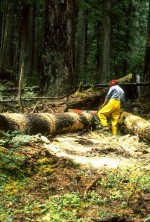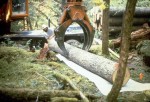AND LTER marks 20th anniversary of 200-year study
The year 2005 marked the 20th anniversary of a very long-term study being conducted as part of the Andrews' long-term ecological research. In 1985, researchers at Andrews began a 200-year experiment to examine the factors controlling the decomposition and nutrient release from logs. Four tree species that range in size from 1 cm to 70 cm diameter, with differing decay-resistances, are being studied. The trees were felled, bucked into logs, and then transported to six old-growth sites on the Andrews Experimental Forest in collaboration among the LTER scientists, the U.S. Forest Service, and a private logging company.
After being characterized for initial bulk density, moisture, and nutrient content, the logs were mapped to help future location. Thereafter, resampling was done annually for eight years, then every other year until year 12, and now at 4-year intervals. This year samples were again taken from a subset of the logs, and although quantitative analysis is not complete yet, some differences are quite striking:
- Species of tree did in fact matter. Pacific silver fir lost approximately 6 percent of its mass every year, compared to nearby western red cedar logs that lost only 0.7 percent of their mass. Therefore, there can be an order of magnitude difference among species of trees. The Pacific silver firs are clearly collapsing into the forest floor, and while punching through an entire log is not a standard measurement, it is now possible with these trees. We have found that western hemlock (2.3 percent per year) decomposes faster than Douglas-fir (1.9 percent per year), but this difference is much less than was reported in early studies from the Andrews Forest. The initial finding was largely caused by differences in sizes of the species, which has since been controlled.
- Examinations of the various parts of the logs indicate that the bark and sapwood of all the species are similar in terms of loss rates. The same is not true of heartwood, with Pacific silver fir decomposing very fast and western red cedar very minimal. Decomposition of the latter is so slow that we think all the other parts will largely have disappeared in another decade, leaving a core of solid wood.
- In addition to differences in rates of decomposition between the species, we observed a short but significant lag before decomposition began in all the species. Decomposers take considerable time in colonizing the large pieces of wood, but this lag was not evident in diameters less than 10 cm. Therefore, the wood diameter has a large impact on the rate of decomposition—depending on the decay-resistance of the species being examined. For species with low decay-resistance the decomposition rate decreased two-fold as the diameter increased from 1 cm to 50 cm. But for decay-resistant species such as western red cedar, the decrease was almost 20-fold, suggesting that the increase in heartwood as log size increases causes much larger decreases than effects related to surface area-to-volume ratios, or colonization limitations.
- Finally, despite having very similar nutrient contents and organic matter constituents, Pacific silver fir and western hemlock decomposition rates differed by a factor of two. One hypothesis points to differences in the decomposer communities that break down these species. This hypothesis is, at least, visually supported: the former is broken down by white-rot fungi (which break down all the polymers and often prefer lignin), whereas the latter is broken down by brown-rot fungi (which cannot break down lignin). This observation suggests that, for wood decomposition, the fungal groups can have a large impact on decomposition dynamics and, ultimately, stores of carbon in forests.
While our next sampling is not due for another decade, we have a lot of data to analyze on both the nutrient content and dynamics of organic matter decomposition of dead trees.

 Enlarge this image
Enlarge this image
